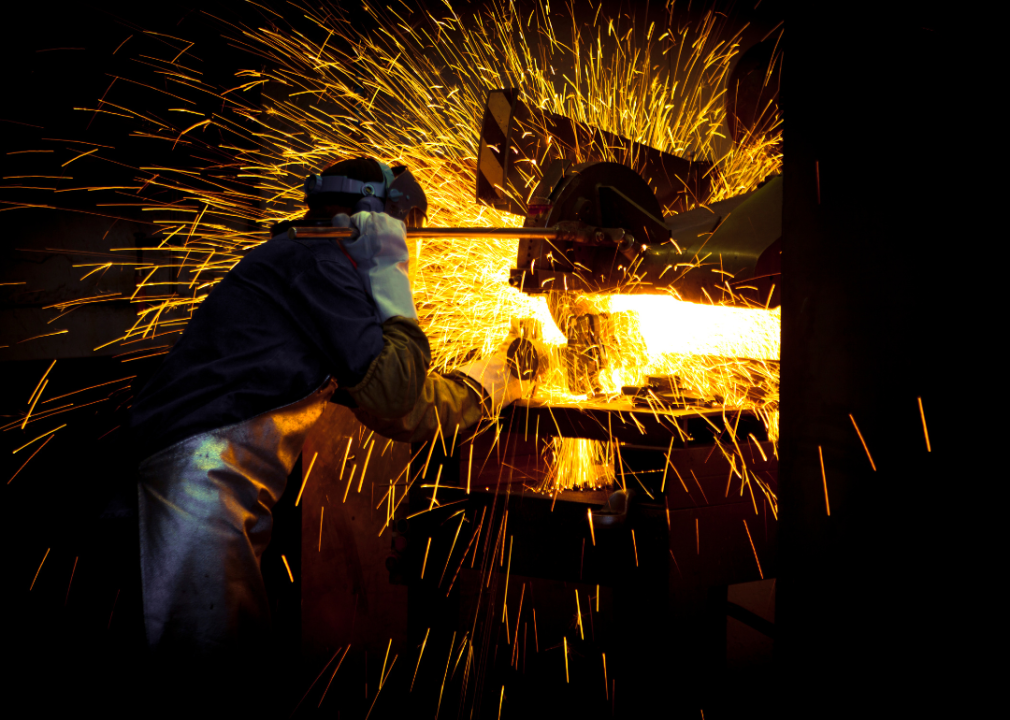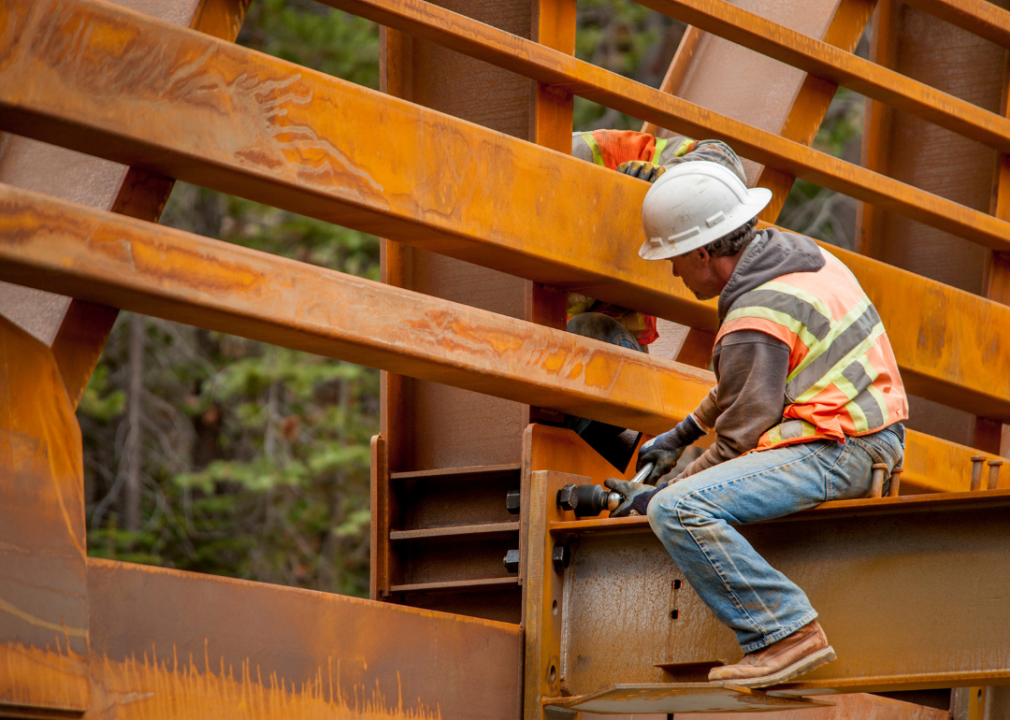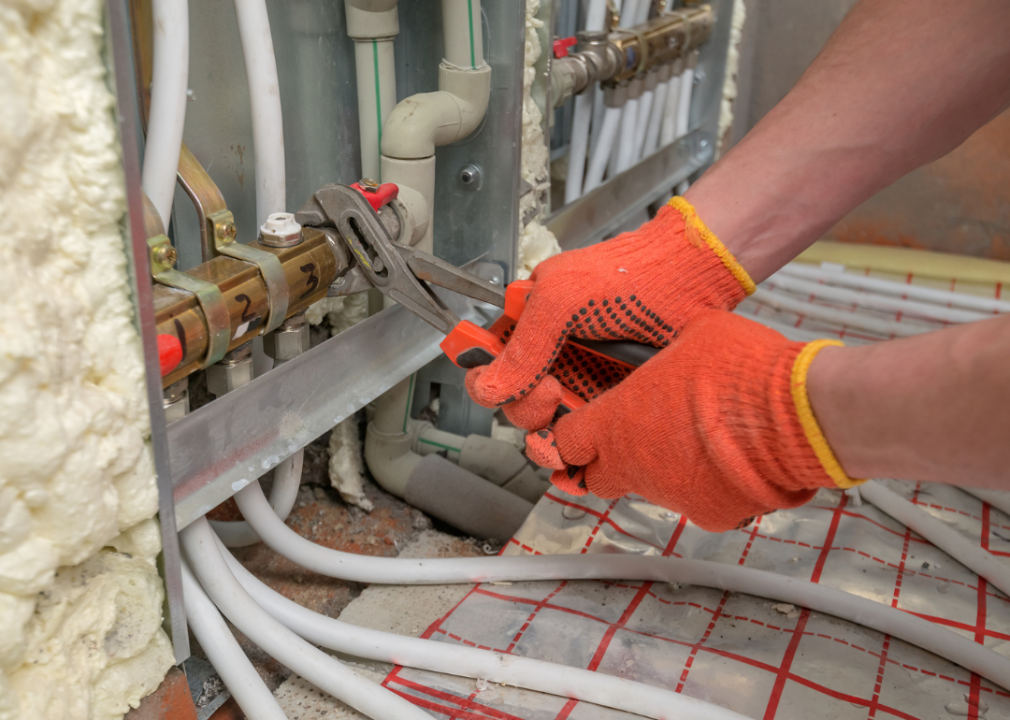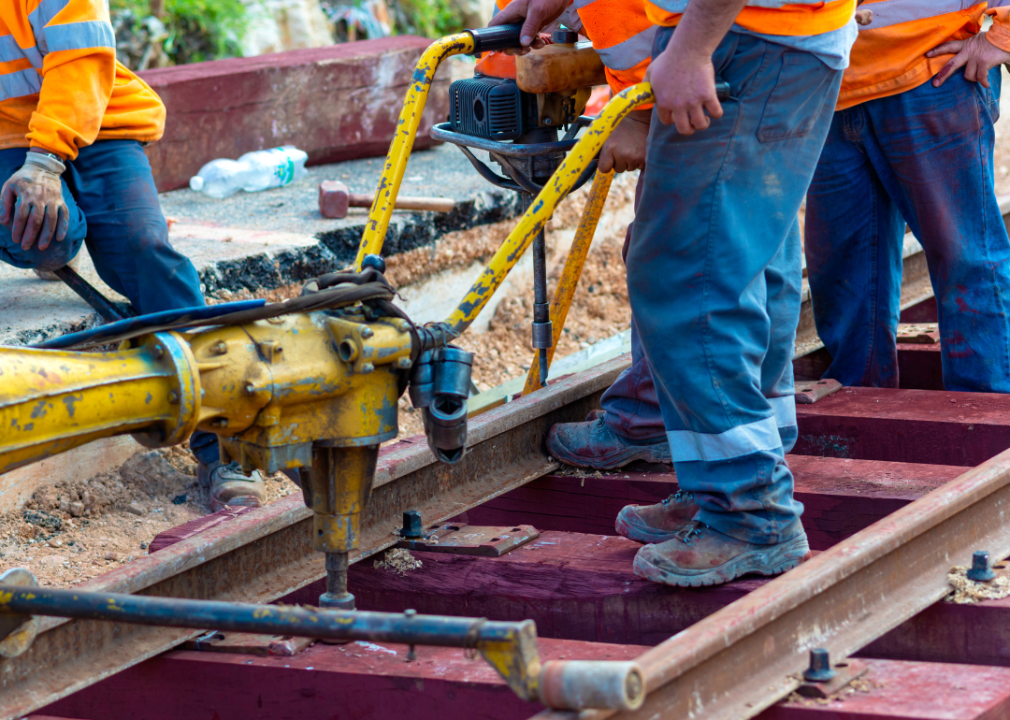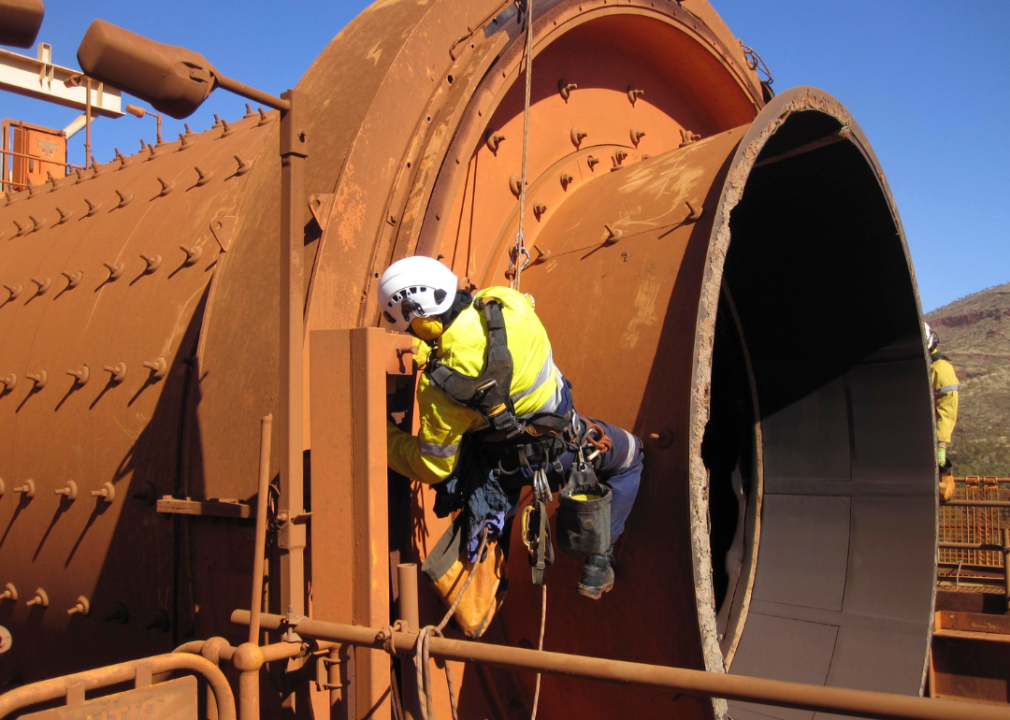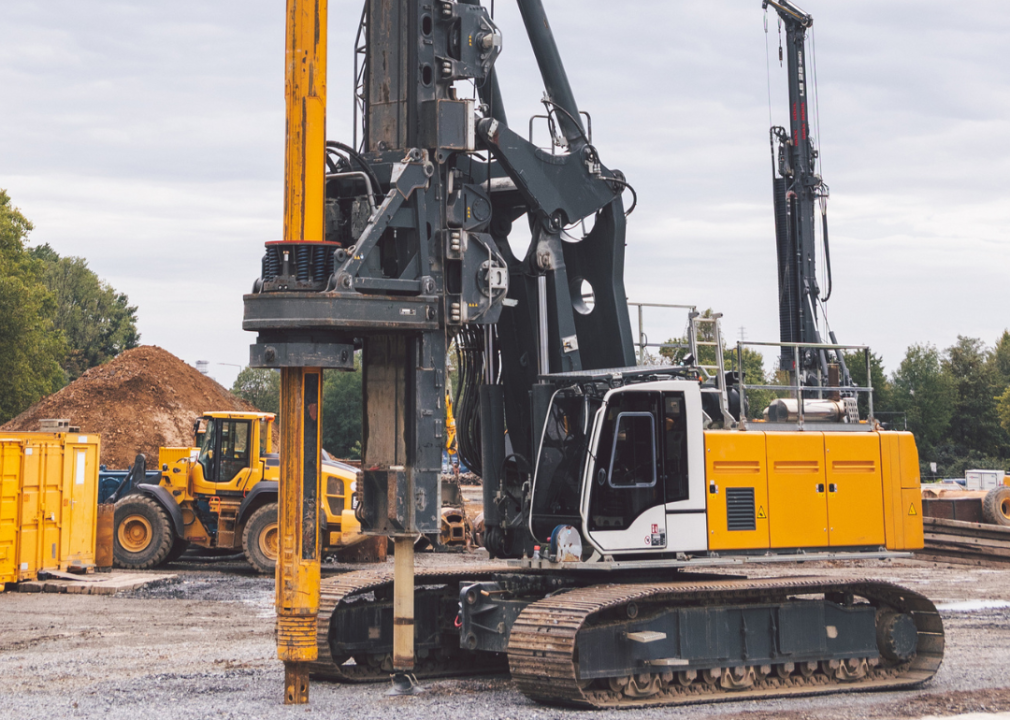These skilled trades jobs pay more than $50K
Canva
These skilled trades jobs pay more than $50K
A worker grinding steel surrounded by flying sparks.
When the COVID-19 pandemic began and people were suddenly spending more time at home, many started looking at repairs and renovations they’d put off. For employers and commercial building owners, having fewer workers in the office made it an ideal time to schedule renovations and other structural improvements without disrupting business. Though the timing seemed right to address such issues, obstacles presented themselves: supply chain hiccups and a shortage of workers in skilled trades.
Between the housing market upswing and infrastructure advances, employment opportunities exist in the residential, commercial, and government sectors. When looking at salaries for these jobs, ServiceTitan examined 2021 data from the Bureau of Labor Statistics. The U.S. Census Bureau reported the median annual wage for jobs in skilled trades is $56,287. Most of these professions don’t require a costly investment in higher education, instead depending on apprenticeships and on-the-job training.
This list includes the top 10 skilled trade jobs within this target salary range. Below is information about each position, potential areas of expertise, an overview of the education and training typically required for each trade, as well as the projected employment growth from 2020 to 2030.
![]()
Canva
Sheet metal workers
A sheet metal worker in a yellow hard hat.
– Median annual wage in 2021: $53,440
– Typical education needed for entry: High school diploma or equivalent
– Typical on-the-job training needed: Apprenticeship
– Projected employment change (from 2020–30): 3.6%
Sheet metal workers fabricate, install, and maintain thin steel aluminum and alloyed metal sheets. Most commonly, sheet metal workers can be found in manufacturing, infrastructure, and construction fields. Heating, ventilation, and air conditioning ducts, home exterior siding, metal lagging of mechanical systems, and outdoor signage are just a few types of jobs sheet metal workers tackle.
There are several specializations in sheet metal work. Those in fabrication—or precision sheet metal workers, also known as metal and plastic machine workers—make parts for various industries. This often finds them using computer-aided drafting and design systems, lasers, and automated machinery.
Contributing to the 3.6% rise in sheet metal worker jobs forecast through 2030 are changes in the housing market and U.S. investments in infrastructure. Additionally, new energy-efficient equipment coming to market will lead to increased calls for installation work. New technologies, such as prefabricated duct systems in residential construction, could hinder these numbers from rising higher.
Canva
Structural iron and steel workers
Two men working on steel bridge construction.
– Median annual wage in 2021: $58,550
– Typical education needed for entry: High school diploma or equivalent
– Typical on-the-job training needed: Apprenticeship
– Projected employment change (from 2020–30): 5.9%
Ironworkers are involved in the construction, rehabilitation, reinforcement, and even demolition of bridges, roads, and buildings.
Structural iron and steel workers erect structural frameworks using levels, lasers, tag lines, and plumb bobs, then join them with bolts, wires, and welding. Ironworkers assemble the cranes and derricks used on these building sites, too.
With the U.S. focusing on infrastructure improvements to structures such as old bridges and highways, ironworkers are set to see a 6% increase in demand between now and 2030. A surge in growth was first noticed during the recovery from the COVID-19 recession in 2020. The U.S. Environmental Protection Agency is currently planning water infrastructure efforts using State Revolving Funds, which will call for ironworkers. However, special tying and placing equipment entering the market could hinder growth in the future.
Canva
Brickmasons and blockmasons
Two brickmasons laying stones.
– Median annual wage in 2021: $59,340
– Typical education needed for entry: High school diploma or equivalent
– Typical on-the-job training needed: Apprenticeship
– Projected employment change (from 2020–30): -5.3%
Masonry workers, or masons, use brick, stone, and concrete in the construction of everything from buildings and dams, to walkways and roads.
Expertise is often based on the materials used. Brickmasons, also known as bricklayers or blockmasons, use materials including brick, terra cotta, and concrete blocks to construct and repair structures. Refractory masons specializing in high-temperature work with furnaces, fireplaces, and industrial sites, also fall under this category. Taking on detailed work are cement masons and concrete finishers who prevent defects in sidewalks, walls, columns, and other structural components made from concrete.
Granite, marble, and limestone are various types of stone materials that fall under the expertise of stonemasons, who use them when building structures and other surfaces. Floors, walkways, and patios are also created by terrazzo workers and finishers, or terrazzo masons. There is some crossover in their skills with that of cement masons.
Changes in materials and installation practices are projected to decrease the need for masons of all types of expertise in the future.
Canva
Plumbers, pipefitters, and steamfitters
A pipefitter wearing orange gloves tightening pipes.
– Median annual wage in 2021: $59,880
– Typical education needed for entry: High school diploma or equivalent
– Typical on-the-job training needed: Apprenticeship
– Projected employment change (from 2020–30): 5%
Though they may use different approaches or techniques, plumbers, pipefitters, and steamfitters all install, inspect, test, repair, and maintain pipelines, piping systems, and fixtures used to convey water, gas, and other substances.
Depending on the materials they use, plumbers, pipefitters, and steamfitters may specialize in either residential (copper, steel, and plastic pipe materials) or industrial projects (large steel pipe materials).
Plumbers, who are considered journey- or master-level depending on their training and experience, fall into the residential category and primarily deal with water, gas, and piping systems for homes and businesses. Pipefitters and steamfitters (or fitters) specialize in systems found in industrial, manufacturing, and commercial industries, which may carry chemicals, acids, and gases.
The projected 5% growth in employment for plumbers, pipefitters, and steamfitters is based on the 2020 recovery from the COVID-19 recession, which brought an influx of new construction. There is also an increased call for sprinkler fitters as states update building codes for fire suppression systems.
Canva
Electricians
An electrician working with wires and lights in the ceiling.
– Median annual wage in 2021: $60,040
– Typical education needed for entry: High school diploma or equivalent
– Typical on-the-job training needed: Apprenticeship
– Projected employment change (from 2020–30): 9.1%
Think of an electrician’s duties, and the mind generally goes to installation, maintenance, and repairs of equipment and control systems, specifically those for the electrical power, communications, lighting, and wiring found in homes, businesses, and factories.
Many electricians, however, begin their work before installation takes place. Experienced electricians are often called to join a team of architects and engineers when they design a new electrical system. Another area of expertise can be seen in the work of lineman electricians, who install distribution and transmission lines.
What’s on the horizon for electricians? Currently, there are projections for 84,000 job openings per year. As the U.S. government explores alternative sources of power, the field should continue to expand, as electricians will be required to link solar and wind generators to power grids and homes.
In August, the government’s passage of the Inflation Reduction Act was applauded by the National Electrical Contractors Association, which pointed to the $369 billion investment in domestic energy production and manufacturing that “will provide NECA contractors with new opportunities to modernize our energy portfolio and create good-paying jobs across America.”
Canva
Tapers
A man building a drywall ceiling.
– Median annual wage in 2021: $61,080
– Typical education needed for entry: No formal educational credential
– Typical on-the-job training needed: Moderate-term on-the-job training
– Projected employment change (from 2020–30): 0.5%
Tapers, or finishers, prep wallboard for paint or wallpaper. They also repair damaged wallboard. Often, tapers work in conjunction with drywall and ceiling tile installers. Drywall installers, known as drywallers or hangers, cut and hang wallboard. Ceiling tile installers, or acoustical carpenters, install tiles to ceilings to block sound. Many tapers perform all three skills on their own.
Future employment growth for drywall and ceiling tile installers is projected to remain steady, whereas that for tapers looks to decline due to new tools hitting the market.
Canva
Construction and building inspectors
Building inspectors walking on a construction site.
– Median annual wage in 2021: $61,640
– Typical education needed for entry: High school diploma or equivalent
– Typical on-the-job training needed: Moderate-term on-the-job training
– Projected employment change (from 2020–30): -2.9%
Before work at a site even begins, construction and building inspectors enter the scene to review plans. Their presence continues as construction progresses, whether it be of a home, building, highway, dam, or bridge. Their eagle eyes, and a bevy of tools, ensure everything is compliant with the latest building codes, zoning regulations, and any other ordinances.
Many inspectors have specialties. Architectural requirements and structural quality fall under the purvey of building inspectors. Fire inspectors make sure buildings meet fire codes. Coating inspectors keep an eye on the proper application of protective layers of exterior paint and coatings used on everything from bridges to pipelines. Others specialize in electrical systems, elevators, residences, mechanical systems, plumbing, public works, and construction.
So why will there be a decreased demand of -2.9% for inspectors in the future? The government’s use of remote inspections.
Canva
Rail-track laying and maintenance equipment operators
Railway workers bolting track rail.
– Median annual wage in 2021: $61,690
– Typical education needed for entry: High school diploma or equivalent
– Typical on-the-job training needed: Moderate-term on-the-job training
– Projected employment change (from 2020–30): 5.3%
This profession has many titles ranging from machine operator and track inspector to track walker and, simply, trackman. Also falling under this category are ballast cleaning machine operators and railroad bed tamping machine operators.
These workers lay, repair, and maintain track for railroad service, be that in commuter service, plant yards, quarries, mines, or pits for sand and gravel.
As of 2020, 15,700 workers held these positions. New jobs expected between now and 2030 come in at a scant 800.
King Ropes Access // Shutterstock
Boilermakers
A boilermaker wearing a safety harness, hanging on a rope at a construction mining site.
– Median annual wage in 2021: $64,290
– Typical education needed for entry: High school diploma or equivalent
– Typical on-the-job training needed: Apprenticeship
– Projected employment change (from 2020–30): -1%
Boilermakers specialize in keeping boilers, tanks, and vats that hold chemicals in efficient—and safe—working condition. This equipment is typically found in buildings, factories, and ships, and boilermakers must conduct tests and inspections to ensure worker and environmental safety.
It’s critical to assemble and maintain this machinery against defects because they’re often heating liquids or gases under extreme pressure. A boilermaker could be called upon to repair blast furnaces, inspect water treatment plants, or install heat-resistant materials in high-pressure tanks.
Boilers are generally built to have long lifespans, but boilermakers are often called on for repairs. So why the -1% projected decline for the profession? The U.S. is shifting to renewable energy, much of which does not require boilers.
Canva
Pile driver operators
Yellow vertical pile driver machine.
– Median annual wage in 2021: $76,260
– Typical education needed for entry: High school diploma or equivalent
– Typical on-the-job training needed: Moderate-term on-the-job training
– Projected employment change (from 2020–30): 4.8%
Working with heavy-duty pieces of equipment, pile drivers hammer steel, concrete, and wood pilings into the ground, or in some cases underwater, most often in the early stages of construction of retaining walls, bulkheads, and foundations of structures. Workers manning pile drivers might be found doing so from skids, barges, crawler treads, and locomotive cranes.
United Brotherhood of Carpenters pile drivers have expertise vital for working with marine construction and offshore wind projects, which are significant in scope. A job requirement that may come into play is commercial diving.
Looking to break into pile driving? One place to start is by looking at the states with the highest employment of pile drivers: California, Washington, Florida, Louisiana, and Tennessee. Explore industries that regularly hire pile drivers, such as highway, street, and bridge construction, mining, as well as nonresidential building construction.
miguel curiel mena // Shutterstock
Elevator and escalator installers and repairers
A person welding metal in an elevator under construction.
– Median annual wage in 2021: $97,860
– Typical education needed for entry: High school diploma or equivalent
– Typical on-the-job training needed: Apprenticeship
– Projected employment change (from 2020–30): 6.1%
Elevator and escalator installers and repairers, also referred to as elevator and escalator constructors or mechanics, install, maintain, repair, modernize, and replace equipment such as elevators, escalators, chairlifts, and moving walkways. Working with electronics, electricity, and hydraulics is required for most of these positions.
The employment outlook for elevator and escalator mechanics is forecast to grow along with the influx of new development of nonresidential buildings. The typical lifespan of an elevator is 25 years. This means buildings with older equipment will need to repair, maintain, and replace equipment to meet American Disability Act requirements.
This story originally appeared on ServiceTitan and was produced and
distributed in partnership with Stacker Studio.
